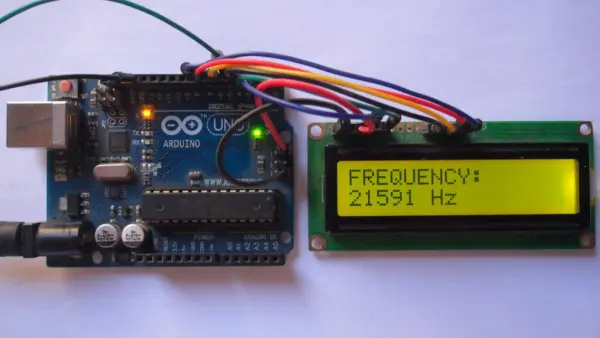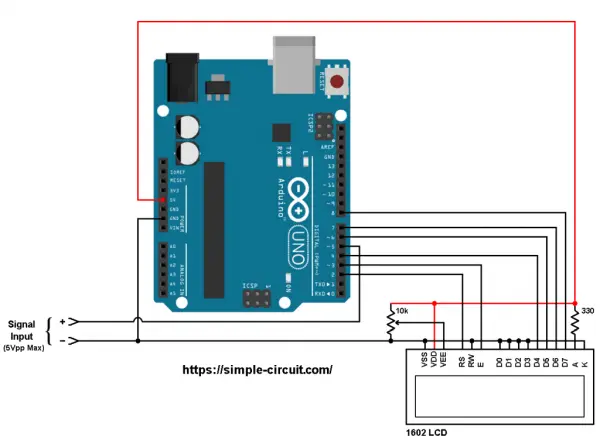Summary of Arduino Frequency Counter Tutorial for Electronics Enthusiasts
This guide explains building an Arduino UNO-based frequency counter that measures PWM signal frequencies up to 5V and displays the readings on a 16×2 LCD. The device uses the FreqCount library to count pulses over one second using Arduino's Timer/Counter modules. The LCD shows frequency in Hertz with a contrast controlled by a 10k ohm potentiometer. The PWM signal is input via Arduino's digital pin 5, and the LCD is connected through specific Arduino pins with a 330 ohm resistor for backlight.
Parts used in the Arduino Frequency Counter:
- Arduino UNO board (Atmega328P based)
- 16×2 LCD screen
- 330 ohm resistor
- 10k ohm potentiometer (variable resistor)
- Breadboard
- Jumper wires
In this guide, learn to construct a frequency counter device utilizing an Arduino UNO board. This device showcases signal frequency values on a 1602 LCD screen. It is designed specifically to measure the frequency of PWM signals that have a peak voltage of 5V.
Hardware Required:
Sure, here’s a rephrased list of the components needed to complete this project:
– Atmega328P datasheet (for Arduino UNO board)
– 16×2 LCD screen
– 330 ohm resistor
– Potentiometer (10k ohm variable resistor)
– Breadboard
– Jumper wires

Arduino frequency counter circuit:
The following details the circuit diagram for the project.
Utilizing a 16×2 LCD screen with 2 rows and 16 columns, it serves to exhibit the frequency and period values of the input voltage. Here’s the pin mapping configuration:
– RS connects to Arduino digital pin 2
– E connects to Arduino digital pin 3
– D4 connects to Arduino digital pin 4
– D5 connects to Arduino digital pin 6
– D6 connects to Arduino digital pin 7
– D7 connects to Arduino digital pin 8
– VSS, RW, D0, D1, D2, D3, and K link to Arduino GND
– VEE connects to the output of the 10k ohm variable resistor (or potentiometer)
– VDD links to Arduino 5V
– A connects to Arduino 5V through a 330 ohm resistor
The VEE pin regulates the LCD contrast, while A (anode) and K (cathode) designate the back light LED pins.

The PWM signal comprises two pins, designated as positive (+) and negative (-), and they are linked to the circuit as demonstrated earlier.
The positive terminal links to Arduino’s digital pin 5, while the negative terminal connects to the Arduino GND pin.
Arduino frequency counter code
The Arduino code provided necessitates a supporting library, namely FreqCount, to facilitate the project process. This library can be acquired through the Arduino library manager (accessible via “Manage Libraries…”), or alternatively, it can be installed manually by obtaining and installing its zip file. Below is the download link for the Arduino FreqCount library:
Direct link to Arduino FreqCount library
The FreqCount library utilizes the Timer/Counter1 module to tally the number of pulses within a set duration. For this specified duration, the Timer/Counter2 module is employed.
Full Arduino code:
